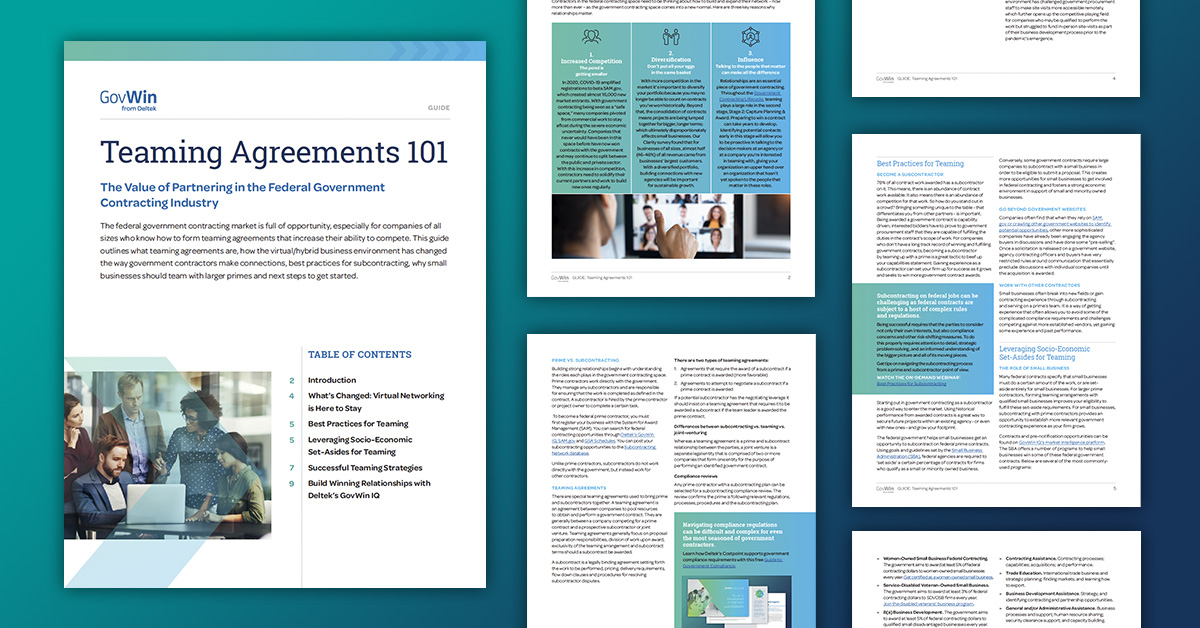What is Subcontracting?
The United States government spends hundreds of billions of dollars annually on contracts. To claim as big a slice of that pie as possible, prime contractors routinely enlist the services of subcontractors to partner to provide the goods and services that the government needs.
Keep reading to learn more about what government subcontracting is and the best practices to follow when subcontracting government contracts for both primes and subs.
In This Article:
Government Subcontracting: The Basics
If you’re wondering how to subcontract with the government, here’s a brief primer, as well as the key differences between prime contractors and subcontractors.
Government Prime Contractor
A prime contractor is an independent contractor that works directly with the government. According to the U.S. General Services Administration (GSA), prime contractors have the responsibility of making sure the work is completed as expected in the designated amount of time and managing any subcontractors on the project.
Government Subcontractor
Often a smaller business with fewer full-time employees or one with more specialized skills, a subcontractor will work with a prime contractor as a part of the larger overall agreement. Subcontractors do not work directly with the government, but instead work on specialized tasks for other contractors (primes).
As a government subcontractor, you will want to be able to understand the government market in the areas of your company's expertise. For example, if you mostly work in the construction industry, you may want access to market intelligence on government construction projects in your area so your firm can come off as knowledgeable and prepared when you're seeking subcontracting opportunities.

Essential Subcontracting Considerations
Register for this free, on-demand webinar to learn how prime contractors and subcontractors alike can successfully navigate the subcontracting process.
How Subcontracting Works
When primes win business from the federal government, they often look to hire subs to be responsible for certain clauses in the contract. By doing so, they're able to take on more and larger projects without having to hire more workers themselves. At the same time, subcontracting also enables small businesses to get work from the government they wouldn't be able to land themselves, albeit indirectly.
With the proper contractual arrangements in place, successful subcontracting is a win-win-win scenario for all three parties: the federal government, the prime and the sub.

Federal Government Contracting 101
Download your free guide to understand the different types of government contracts, how to register to do business with the federal government and ways to capture new federal sales opportunities.
Federal Subcontracting Disputes
Unfortunately, not every subcontracting contract leads to smooth outcomes for all parties. For example, it's not uncommon for subs and primes to get into disputes when contractual relationships aren't created as thoroughly as they should be.
The good news is that by doing your due diligence and understanding the best practices of subcontract management, you can avoid such disputes, leading to better outcomes for both sides of the equation.
How to Manage Government Subcontracting
Subcontracting is like any interpersonal relationship. If you want things to go well, you need to treat the other side with respect. Since two parties are going to be working together, both sides want to make sure the other is accountable and is pulling their own weight.
In a subcontracting arrangement, primes and subs often find themselves in otherwise avoidable predicaments because they don't do their due diligence when it comes to creating and agreeing to subcontracts. They also may be operating under different time frames or have different ideas of how to complete the work.
Ensuring successful engagements between primes and subs over the course of an entire project starts with taking the right approach. To do this, both sides need to follow several steps.
Operate with integrity and work together in a cooperative spirit
Whenever you, as an independent contractor, are working with the federal government, the work is typically governed by laws and regulations. As such, primes don’t have a lot of wiggle room. Since an issue will almost certainly come up during the course of the original contract, it's important for both primes and subs to know who they're getting into business with and make sure that the party intends to operate with integrity and be as cooperative on their current project as they can.
Communicate effectively, honestly and transparently
For the best results, both parties need to be honest and transparent, communicating any issues as they arise. That way, they stay on the same page. Understanding that subs might not have as much experience working with the government, it's imperative that primes tell their subcontractors to report any issues or project risks that come up immediately since a failure to do so could result in a contractor incurring a loss of certain claims.
Be understanding of the subcontractor or prime contractor’s concerns
The kinder you are to your business partners, the better things generally turn out. By understanding where the other side is coming from, you get a better understanding of your negotiating power. For example, when a sub understands why a prime is thinking of things in a certain way, they'll know where pushing back is a non-starter. At the same time, they'll also know where primes can modify project details in a way that's acceptable to them.

Partnering Strategies for Set-Aside Contracts
Join government contracting attorney Maria Panichelli as she walks you through how to properly use partnering strategies such as teaming, joint ventures and mento protégé relationships.
What is a Teaming Agreement?
A teaming agreement is generally defined as a contractual agreement between a potential prime contractor and another company to act as a subcontractor under a specified federal government contract or acquisition program. Teaming agreements are not actually enforceable or binding until the prime contractor wins the government contract and awards the subcontract to the subcontractor.
The guide below offers a complete explanation of what teaming agreements are and how your business can benefit.

Free Guide: Teaming Agreements 101
Discover how the virtual business environment has changed the way government contractors make connections, best practices for subcontracting, why small businesses should team with larger primes and next steps to get started.
What is a Flow-Down Clause?
In government contracting, a flow-down clause is a Federal Acquisition Regulation (FAR) that essentially stipulates that the subcontractor will be bound to the contractor in the same manner that the contractor is bound to the government. In some cases, flow-down clauses refer to other risk-shifting provisions that protect prime contractors in the event their subs mess up.
Understanding the perspectives of both primes and subcontractors is crucial when it comes to flow-down clauses in subcontracts.
Primes, for example, are concerned about potential issues such as delays, defaults or deficiencies in work from subcontractors. Their primary goal is to avoid jeopardizing their relationship with the government or facing default or termination.
In the event of problems, primes aim to avoid being caught in the middle, managing issues with both the government and subcontractors. To mitigate this risk, primes ensure that the subcontractor’s obligations are aligned with their own obligations to the government.

7 Tactics for Subcontracting Success
This guide explores the importance of choosing the right partners, the distinct nature of government contracting and the essential elements to include in these contracts.
Best Practices for Pass-Through Claims
Sometimes over the course of a government contract where prime contractors and subcontractors are working together to fulfill the government's needs, a dispute may arise - this is not uncommon when many parties with different interests are working together. Unlike primes, subs don’t have a direct path to submitting claims against the federal government. That's because the government has sovereign immunity and only parties that are contractually bound to the government can enter into litigation with it.
In the event the government suspends a project in a way that causes the sub to incur damages or delays that they weren't anticipating, they need to put together a claim and ask the prime to sponsor it, thereby passing it through to the federal government.
This is a long and arduous legal process that can become a huge source of conflict in sub-prime relationships. On one hand, the prime is worried about being stuck in the middle of an argument between the government and their sub — and that they might be responsible in the event the sub is acting fraudulently. On the other hand, the sub is worried about not having a direct remedy for a claim and not being able to endure a lengthy process even if they do.
Subcontracts must be drafted in a way that addresses these concerns, including the following:
- Outlining which issues the prime will sponsor
- How subs will help in the preparation and litigation of a sponsored claim
- What will happen in the event a sub commits fraud during this process
Subcontractors should also include arbitration clauses, dispute clauses and liquidating agreements in the original contract to cover every possible scenario. It's important to be as prepared as possible so your team can focus more of its valuable time on finding and winning more government business.

Grow Your Government Sales Pipeline
Fill your public sector pipeline and win more federal government contracts by following this guide.
Best Practices for Claims Between Primes and Subs
What happens when a prime refuses to honor a subcontract by refusing to pass through a claim that is supposed to be passed through? What happens when a subcontractor doesn’t communicate transparently, which causes issues with a project?
Any issues that might arise between primes and subs need to be addressed in the contractual agreement. This should include topics like mandatory mediation, arbitrability, where disputes will be settled and who’s responsible for covering legal fees.
Next Steps in Government Subcontracting
As you can see, engaging in and managing government subcontracts is no easy feat. But with the right approach, both the prime contractor and the subcontracting company can open themselves up to more government opportunities.
Tools like Deltek's GovWin IQ platform of market intelligence can help both prime and subcontractors. GovWin IQ contains features that makes it easy to identify and track subcontracting opportunities through a simple search. With GovWin IQ, you can be confident that you are always finding the most relevant and reliable subcontracting opportunities for your business.

Find Subcontracting Opportunities with GovWin IQ
Learn how the leading market intelligence platform can help you with prime or subcontracting government opportunities.
Related Resources
Guide to Government Contracting
Get the information you need to successfully find win and manage government contracts.Learn More »
How to Find Government Contracts
Get started by finding government contracts that best fit your business.Learn More »
What is DCAA Compliance?
Learn more about DCAA compliance, and how contractors can reduce risk by avoiding and preparing for DCAA audits.Learn More »
Federal Government Contracting
Learn more about federal government contracts and where you can find them.Learn More »
Small Business Contracting
Discover how to find, win and deliver on small business government contracts.Learn More »
Types of Government Contracts
Learn about the four main types of government contracts that contractors encounter.Learn More »
Canadian Government Contracting
Learn more about the Canadian public sector market and how to find Canadian contracts.Learn More »
How to Win Government Contracts
Discover how to beat the competition and win more government contracts.Learn More »
Guide to Govcon Compliance
Learn why compliance should be top of mind for all government contractors.Learn More »
What is CMMC?
Learn more about the basics of Cybersecurity Maturity Model Certification (CMMC).Learn More »
What is ITAR Compliance?
Learn more about the International Traffic in Arms Regulations (ITAR) and who it applies to.Learn More »
State & Local Contracting
Learn the basics of state and local government contracts and where you can find them.Learn More »
Basics of FAR & CAS
Learn about the Federal Acquisition Regulation (FAR) and Cost Accounting Standards (CAS).Learn More »

 Log In
Log In










